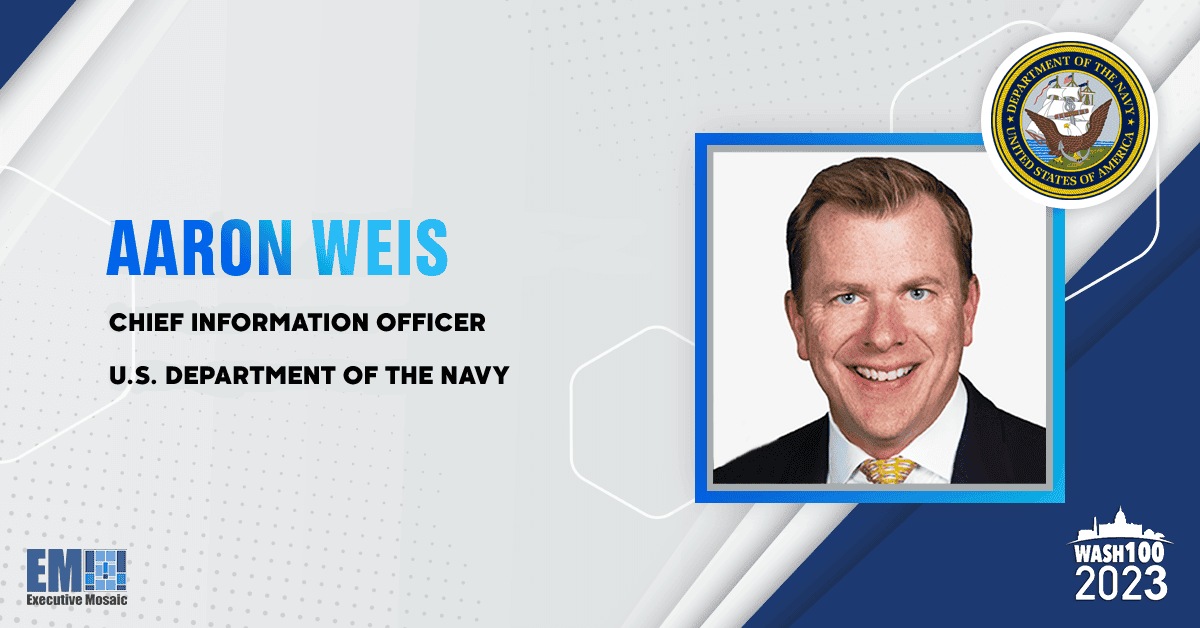Executive Mosaic is honored to introduce Aaron Weis, chief information officer at the Department of the Navy, as an inductee into the 2023 edition of the Wash100 for his leadership in defining digital modernization objectives as part of his information superiority framework for DON in the year ahead.
This is the fourth consecutive year Executive Mosaic has included Weis in the annual Wash100 list of significant contributors to government contracting activity.
In December, Weis issued its fiscal year 2023 campaign plan that lists concentrations to achieve the objectives of the Information Superiority Vision.
The FY 2023 set of objectives has six focus areas to help meet ISV goals: optimization of the DON Information Environment for cloud; adoption of enterprise services; implementation of zero trust; use of data to fuel force readiness; Cyber Ready; and Cattle Drive.
Weis said implementing the campaign plan is a “team sport.”
“Cooperation continues to be the key to execution. Successful execution of the FY 23 campaign plan requires active involvement from champions across the DON,” he added.
In September, Weis signed a design concept outlining an integrated framework to achieve digital modernization goals across the U.S. Navy and Marine Corps.
The Capstone Design Concept for Information Superiority serves as an integrated framework for accomplishing DON’s vision to move any information from anywhere to anywhere in a secure manner.
“Successful completion of our mission to modernize, innovate, and defend our information to achieve a digital edge that no adversary can match depends on our ability to design, develop, and deploy the best technical solutions,” said Weis.
In April, he told FCW that a fundamental change in IT architecture could help DON increase the agility and security of its enterprise network and that the service branch seeks to transform how it operates and protects the network with software-defined technology.
He noted that the Navy is transitioning to an enterprise IT-as-a-service model as part of its Information Superiority Vision and cited how a network could drive that mission.
"We're working to stand up a portfolio of enterprise services that organizations can use instead of having to build, so it's sort of build once use many," Weis said.
"And so the network architecture will support that and an enterprise service approach. And then sort of layered on top of that is the cloud-delivered capability that's coming across the core — the first element of which is really flexibility,” he added.
When it comes to cybersecurity, Weis said he believes conducting regular automated red-teaming is far more effective than adopting a “checklist” approach when it comes to detecting and addressing cyber vulnerabilities.
“It’s a very compliance-driven mentality, like an audit… and it’s wrong,” Weis told Defense One of the checklist approach. “Cybersecurity is not a compliance problem.”
At a forum in April, he said the Navy is advancing several lines of effort to adopt a more holistic approach to cybersecurity and these include continuous monitoring with program-driven red teaming and auto-red teaming, preparing the workforce and acquisition changes.
Weis also cited that modernizing the service’s infrastructure, defending the branch’s information “wherever it is” and driving innovation at speed are the three major goals the Navy intends to achieve based on the 2019 Cyber Readiness Review.
In May, the Naval Postgraduate School and Microsoft signed a cooperative research and development agreement to assess the potential military applications of commercial technologies.
The joint research projects between NPS and Microsoft will look at operational uses of intelligent edge computing and cloud-enhanced networks; identify ways to incorporate gaming, exercising, modeling and simulation into command decision-making; and develop smart campus in Monterey.
Weis said DON is finding new ways to drive the operational capabilities of its components through research and development.
“This agreement between NPS and Microsoft takes that initiative to the next level, creating a defined cooperative research collaboration between a global tech giant and the capabilities it brings to bear, with the Navy’s leading science and technological university, where operationalizing innovation is core to their mission,” Weis added.
In a March interview with Federal News Network, Weis discussed how the Navy leverages cloud services to accelerate its IT transformation efforts. He became one of the pilot users of a new virtual desktop interface that uses cloud services, does not require the use of common access cards, is equipped with endpoint detection capabilities and can be administered by Navy Cyber Defense Operations Command.
“It’s fully integrated. It is tied in with our cloud storage,” he said. “So my Azure cloud storage that I have on my desktop is fully accessible there. All your documents are there. You have the full suite of Office 365 capability. It is enabled, CAC-less authentication.”
Weis initiated three initiatives to standardize and coordinate IT modernization across the Navy and these are Operation Flank Speed, which was the Office 365 implementation; application rationalization effort Operation Cattle Drive and Super Nova, which seeks to consolidate analytics tools and systems used across the department.
These digital transformation initiatives seek to achieve savings in order to invest in cybersecurity. Weis highlighted the role of cloud in protecting and defending data from cyberthreats.
“Cloud is an integral part of that effort to defend our information as we transition to cloud-based solutions, cloud-delivered applications and cloud-delivered infrastructures,” he said. “Then, we’re going to leverage that capability to improve our ability to defend our information through heightened cybersecurity, augmented by a different footing in cloud.”
Executive Mosaic congratulates Aaron Weis and the Department of the Navy team on their 2023 Wash100 win. Don't forget to vote for your favorite awardees at Wash100.com.





